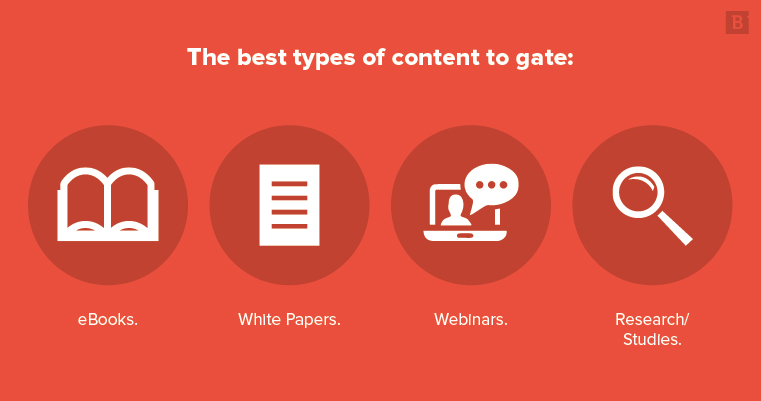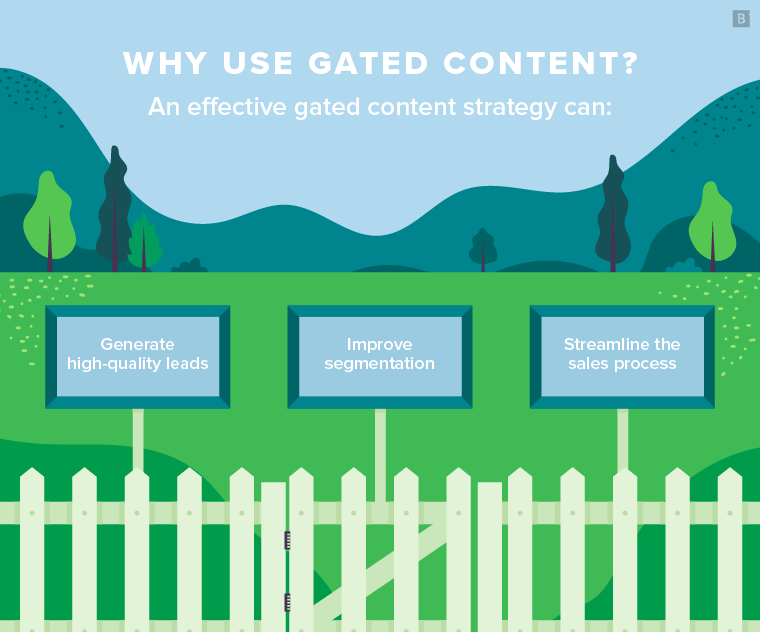Gated content is a subject of heated debate among marketers, and certainly among audiences who consume online content every day.
Marketers who use gated content believe it’s an effective way to generate highly targeted leads. Opponents believe that withholding content and demanding something in return will frustrate their audience, particularly when so much free content is already available on the web.
So, who is right?
As you can guess, the answer’s not so simple. Gating your content provides a number of benefits and drawbacks. If you want to reap the rewards of gated content without stumbling into the potential pitfalls, there are many considerations you must make before putting your strategy in motion.
Today’s post will answer everything you need to know about gated content: What it is, who it’s for, how to use it and much more. Let’s get into it!
What is gated content?
Gated content refers to online content that users can only access once they’ve submitted a form. Marketers gate content to generate leads, as these forms typically ask for personal information such as the user’s name, email address, phone number or other important details.
Common examples of gated content types include eBooks, white papers, webinars, resource templates and training videos. Ungated content often includes blog posts, infographics, press releases, images and short videos.

There are no specific rules for what constitutes gated or ungated content, though gated content tends to be (and should be) more in-depth, more thorough and more valuable than the ungated content that marketers offer for free.
Who is gated content for?
Prospects in the early stages of the buyer’s journey are less likely to submit their personal information in exchange for a piece of content. For one, they’re still far from the point of making a purchase and the last thing they want is your company flooding their inbox with promotional emails.
But, the more likely scenario is that they’re less interested in the kind of in-depth, longform content that marketers typically gate. An eye-grabbing infographic might keep their attention; a long eBook, not so much.
Gated content appeals much more to prospects in the middle to later stages of the buyer’s journey. These prospects may still be exploring their pain points, and they might not be ready to make a purchase yet. But, they are seeking content that’s more in-depth and more specific than the free content they’ve already consumed. And, because they’re more serious about addressing their pain points, they’re more likely to give up some personal information in exchange for a helpful piece of content.
Here’s a quick example:
A prospect at the beginning of the buyer’s journey might read and enjoy a blog post titled 10 Social Selling Horror Stories and How to Avoid Them. But, there’s very little chance they give up their contact information to download an eBook titled The 10-Step Process to Building the Perfect Social Selling Strategy. Months later, that same prospect has done significant research about social selling and is ready to get serious about fixing the holes in their own strategy. Now, providing their contact information for an in-depth eBook seems like a worthwhile trade.
Why is gated content effective?
As we’ve already hinted, gated content has its drawbacks. By restricting access to content, you’re not only limiting the amount of people who will engage with it; you’re also opening the door for opposition and frustration from your audience – that’s just a fact. Modern audiences have grown increasingly resistant to the idea of digital content being anything but 100% free, no strings attached.
Considering these drawbacks, is gated content even worth it? Why do marketers gate content and risk limiting, or irritating, their audiences?

Let’s answer those questions by exploring the unique benefits of gated content:
1. Generate high-quality leads
Not only will gated content boost lead volume, it’ll also help you capture more high-quality leads.
Think about it: a sales prospect who is willing to submit their contact information in exchange for content is not just casually browsing the internet. They might be highly invested in learning more about a specific topic, or they might be trying to learn more about your company. As a result, the leads you generate through gating content will be more targeted and of higher quality than the leads you generate through general spray-and-pray tactics.
2. Improve segmentation
Gating content enables you to be more strategic with the information you capture from your inbound leads. In exchange for a content asset, you can ask prospects to provide information related to their industry, job title, the size of their company and more. These details will help you gain insights into your audience and enable more targeted segmentation across all of your marketing campaigns and channels.
3. Streamline the sales process
Lead scoring and routing becomes much more effective when you generate leads through gated content. A prospect requesting a certain content asset can tell you a lot about where they are in the buyer’s journey, how serious they are about making a purchase and what follow-up steps your business must take to make them a customer.
For example, let’s say a Digital Marketing Director submits a form to download a case study. For one, their job title indicates that they’re an ideal customer for the service you provide – and the action of downloading a case study indicates that they’re actively exploring your company’s products. You immediately route them to a sales rep who kicks off an initial conversation by mentioning the case study the prospect downloaded.
When should you gate content?
Marketers like to debate the benefits and drawbacks of gated content, but a more relevant question is: When is the right time to gate content? To answer this question, it’s important to consider the most essential building block to a successful gated content strategy: trust.
Trust has become an increasingly rare commodity in today’s world; more than 50% of customers admit they don’t trust brands. But, if you want people to submit their personal data in exchange for a piece of content, you must first earn their trust. If someone doesn’t trust your brand with their personal information, or if they don’t trust the quality of your content, you won’t see great results no matter how fine-tuned your gated content strategy is.
If your company is still finding its audience, it might not be the right time to invest heavily in gated content. That doesn’t mean you can’t experiment with gating content, but don’t expect it to be the driving engine of your lead generation efforts. Offer high-quality content on a consistent basis, earn your audience’s trust, and then slowly introduce more and more gated content.
How to develop a successful gated content strategy
Throughout this post, we’ve made it clear that gated content has many advantages when it’s used correctly, and several risks when it’s used incorrectly. Here are some tips you can keep in mind to ensure you reap the benefits and avoid the drawbacks of a gated content strategy.
1. Strike a balance between gated and ungated content
The perfect gated content strategy requires a careful balancing act. Many content marketers have fallen into the same pitfall: They start to gate content, they see solid results, and then before they know it, the quality and volume of their ungated content has fallen off a cliff. Every time they write a blog post they love, that devil on their shoulder tells them to bulk it up a little and turn it into a gated eBook instead.
The best way to balance gated and ungated content is through a tactic known as content mapping. Content mapping refers to the process of aligning a content strategy with the various stages of the buyer’s journey. With a content mapping strategy in place, you’ll be able to create a sufficient amount of content that appeals to prospects in each phase of the journey – which in turn makes it much easier to know what content to gate and how much gated and ungated content to produce.
2. Create a landing page for each gated content asset
Landing pages are critical to the process of creating gated content. Remember, your goal is to get people to submit their contact information and then provide them with the content they’re looking for. Think of each landing page as the portal through which this transaction occurs.
Make sure each gated content landing page provides a brief overview of what users can expect from the piece of content. Again, this is a bit of a balancing act. Provide too many details on the landing page, and the user might feel like there’s no need to access the actual asset. Not enough detail, and the user may not understand why the asset is valuable enough to earn their contact information.
3. Promote your gated content
If you’re going to work hard to create super in-depth content and hide it behind a form, you better have a plan for getting your audience to find it. But, the tactics you use to promote ungated content might not work as well for gated content.
For example: You might see great results from promoting blog posts on Twitter, so you think the same strategy will help draw attention to your gated eBooks. But, your followers have grown accustomed to clicking the links in your feed and immediately accessing high-quality content.
Suddenly, they’re trying to access content and hitting the figurative brick wall of a landing page that wants them to give up personal information. Even though there’s nothing wrong with promoting gated content on Twitter, your followers are taken aback by it, and some of them might stop engaging with any of the content you post.
Luckily, there are many ways to ensure your target audience finds your gated content – without annoying the users who aren’t interested in it.
Link to gated content landing pages within related blog posts
Say someone reads your blog post on email marketing best practices and they find it valuable and informative. They won’t break out the credit card and buy your product on the spot; they do, however, want to take the next step and find some more in-depth content about this topic. Why not make it easy for them?
There are several benefits to linking to gated content landing pages throughout your ungated content, especially blog posts. For one, you get the gated content in front of your audience in the most unobtrusive, natural way possible.
Plus, gated content is often an effective “next step” after a related, but less thorough, piece of content. After reading a high-quality blog post on a topic that interests them, prospects will be much more likely to submit their personal information if it means learning more about the topic.
Repurpose gated content into additional assets
Not only can you link to gated content throughout your ungated content – you’ll also find success by repurposing parts of a gated content asset into smaller, supplementary content assets. For example, perhaps you recently published an extensive, longform report that you’ve been working on for months. It makes sense to gate this content, but ultimately, after doing so, you’re disappointed with the results.
You decide to create an infographic using some of the best visual elements of the report. The infographic works well as a standalone piece of content, but it also provides a link so users who want to read more can download the full report. After you publish the infographic, you notice a spike in traffic to the gated content landing page and a surge in download requests of the report.
Include gated content in a content newsletter
Weekly or monthly email newsletters are a great way to promote your content to a targeted audience. Include gated content, like eBooks and white papers, along with ungated content, like blog posts and infographics, so your newsletter offers a variety of valuable content to your audience. Or, segment your email list and personalize your newsletter so that prospects further along in their buyer’s journey receive more in-depth gated content than the rest of your audience.
Final thoughts on gated content
When it comes to marketing strategies, it’s easy to talk in absolutes. We like to declare certain tactics “dead,” “irrelevant” or “outdated,” and we’re quick to label a new approach as “the future” of marketing. The truth always lies somewhere in the middle, and there’s no better example than gated content.
Yes, it’s true that there are unavoidable drawbacks to hiding content behind a web form. It’s also true that gating content can be an incredibly effective marketing tactic when you have the right strategy in place. Above all else, make sure you’re providing your audience with engaging, valuable content, whether it’s gated or free to access. The way people consume and engage with content is always evolving – but high-quality content will always win in the end.





